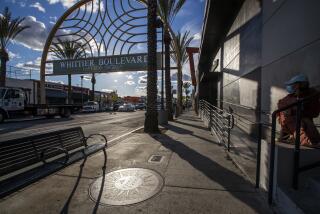Peace Activists Ask Claremont to ‘Adopt’ City in Nicaragua
- Share via
While walking down the street one day during his three-week visit to Quilali, Nicaragua, last month, Jack Nounnan was unceremoniously handed an official-looking document by the city’s mayor.
Upon translating the proclamation, Nounnan, a Claremont resident and part of an eight-member delegation of peace activists from the Pomona Valley, reacted joyously.
Without fanfare or bravado, the mayor of Quilali, Jimmy Rodriguez, had unilaterally declared Claremont the official sister city of his tiny northern Nicaraguan town.
“He just wrote it out on his own,” Nounnan said. “It was an easygoing kind of thing.”
But now, back in California, Nounnan would like to make it more than that.
Along with the two dozen other members of the Nicaragua/Pomona Valley Friendship Project, a group formed to improve relations between the two countries, he is launching a campaign to persuade the Claremont City Council to formally reciprocate.
By engaging in a mutual sister-city relationship, members of the grass-roots group say they hope to shatter stereotypes of Nicaragua and promote an understanding of the troubled Central American country through friendships with its people.
“It would create an opportunity to establish an understanding based on one-to-one relationships,” said Bill Evans, a history professor at Cal Poly Pomona and a member of the delegation that visited Quilali. “It would reject the whole Ollie North perception of foreign policy, this whole cops-and-robbers, simplistic way of looking at the Third World.”
If the Claremont City Council were to act on the proposal, which it has not yet received, Claremont would become one of the first California cities, perhaps the only one, maintaining official ties with Nicaragua.
According to Sister Cities International in Alexandria, Va., only 18 municipalities in the country have established sister-city relationships with cities in Nicaragua. Two of those--Gonzales and La Habra--are in California.
However, officials in Gonzales, a city of 3,900 in the Salinas Valley, say they have no record of any ties with Nicaragua. And La Habra, which became the sister city of Esteli, Nicaragua, on May 5, 1970, and named a city park after the town, has let the relationship wane since the Nicaraguan revolution in 1979.
In Claremont, which already has a sister-city bond with Kumasi, Ghana, and more informal ties with Chernovtsy in the Soviet Union, reaction was mixed.
“I support the sister-city concept,” Mayor Judy Wright said. “I don’t think it’s going to change the world overnight . . . but I think as a City Council we at least need to listen and examine it as a possibility.”
Councilman Bill McCready was less enthusiastic.
“I’m delighted that politicians of other towns think well of our citizens,” McCready said. “But we don’t make a lot of the dedications, proclamations or flowery whatevers. . . . My best guess is that we would not take any action.”
Plans to visit Quilali began fermenting among the Nicaragua/Pomona Valley Friendship Project about a year ago, when several Claremont residents received correspondence from friends and relatives traveling in Nicaragua.
Several of the letters spoke highly of Quilali and the surrounding Bigia Valley, a mountainous area near the Honduran border that in recent years has suffered numerous attacks from the contras fighting Nicaragua’s Sandinista government, the activists said.
The group wrote to the Nicaraguan Embassy in Washington, which facilitated contact with Mayor Rodriguez and other Quilali officials. After many meetings and planning sessions, the eight-member delegation left for Niacargua in mid-June with the hope of establishing a bond with the people of Quilali.
Many of them lived with families in the small agricultural town and looked for answers to their questions about Nicaraguan politics, religion and the condition of life in a war zone.
“When people generally hear of Marxism or Leninism or communism, they generally associate it with aggressive behavior, people who want to take over as many countries as they can,” said Jeff Johnson, a substitute teacher in the Bonita Unified School District, who was part of the delegation.
“But that’s not the case,” he said. “I’m not saying they don’t have Marxist-Leninist ideals in their government, but you can’t just hear those words and then shut a country down. They’re still people.”
Although the group had proposed the idea of a possible sister-city relationship, it didn’t become official until Rodriguez caught up with Nounnan one day and handed him the proclamation.
Signed by Rodriguez under the greeting “For the well-being of humanity,” it stated:
“Fortuitously, we come to one accord in relating as sisters the two cities, Claremont (in California, U.S.A.) and Quilali (in Region I, the Segovias, Nicaragua). . . .
“This historic act of our sisterhood makes it possible for our people to form bonds of relationship more concrete and strong in the future.”
The Nicaragua/Pomona Valley Friendship Project has members from throughout the eastern San Gabriel Valley and western San Bernardino County, but because most of the delegation was from Claremont, it was named as the official sister city, Nounnan said.
“We would like to bring it before the council and just have them recognize that we have done this,” he said. “But the most important thing is that people have the power to make their own connections, regardless of whether or not their leaders see the possibility.”
More to Read
Sign up for Essential California
The most important California stories and recommendations in your inbox every morning.
You may occasionally receive promotional content from the Los Angeles Times.













